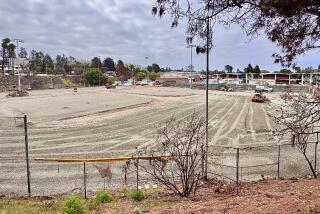New campus has built-in sense of history
- Share via
The leaders of the private Waverly School in Pasadena set out to build a new high school campus. Instead, they created what looks like a well-groomed rural hamlet, with seven wood-frame houses and bungalows wrapped around a grassy quadrangle.
These newly renovated homes-turned-classrooms reflect the personality of Waverly, a kindergarten through 12th grade school rooted in a progressive philosophy of hands-on learning and a strong sense of community.
“It’s nice. It’s homey,” said James Wolf, 14, of Pasadena, a freshman who lounged on the porch of a 1901 bungalow with other students Tuesday afternoon.
“There’s a sense of family,” said freshman Megan Lennon, 14, of Altadena.
The project also stands as a bright spot for Pasadena preservationists, who pride themselves on working to save the city’s architectural treasures, whether Old Town storefronts, the beaux-arts City Hall or these freshly painted sage-green houses. The project includes two Victorian-era homes and four mid-1920s bungalows.
While most people tackle one building at a time, Waverly School officials decided to renovate a collection of dilapidated homes. The high school program was outgrowing its quarters in an office building on Pasadena Avenue just as six old houses went on sale on nearby Waverly Drive.
The school spent $2.4 million for the properties, which had been divided into apartments and sorely needed attention.
“Everything was torn apart and graffitied,” said Heidi Johnson, who is known as the “head of school” rather than headmaster. She keeps enlarged black-and-white photographs of the buildings on the fireplace mantel of her neat sage-and-cream office, a reminder of the 16-month renovation.
School board member Charles E. Loveman Jr. spearheaded the project, drawing on his expertise as executive director of Heritage Housing Partners, a nonprofit Pasadena-based group that buys old properties and renovates them as affordable housing. The high school project cost $4.3 million.
The Waverly School was founded in 1993 as an elementary and middle school and added a high school in 1997. It now has a total enrollment of 314 students, including 93 in the high school.
As it built the new campus, the school added a seventh old home, known as the Dearth House after the family that once occupied it. The gracious 1 1/2 -story home is the most elaborate on the campus, with its gables, decorative vent covers, Eastlake trim and fish-scale shingling.
The Victorian era Dearth House originally stood at 144 W. Valley St. but needed to be moved to make room for a new home development, said Sue Mossman, executive director of Pasadena Heritage, a nonprofit historic preservation group.
So Mossman contacted officials at the Waverly School who decided the 1893 home would be an ideal setting for new mathematics and language classrooms.
The Dearth House was moved and set on a front lot facing Waverly Drive, next to a large coast live oak.
The bungalows, at only 400 square feet, house English and history classrooms. On Tuesday, nine students sat around a U-shaped table in one of the bungalows as history teacher Bernie Weinraub asked them to explain the rise of McCarthyism.
The campus has been named after Dean A. and Janice E. Scarborough, who donated $500,000 to the project. It was dedicated Sunday, and red ribbon from the formal ribbon-cutting ceremony was still wrapped around two pillars outside the administration building.
More work remains to be done. A covered patio is planned, but for now, a cluster of large Japanese-style umbrellas provides shade on the quad.
School officials say the new classrooms are more airy, and those in the little bungalows have windows on four sides.
The age and history of the buildings add a new dimension to students’ education, Johnson said as she stood outside the 1888 administration building.
“Young people are used to everything new -- the new cellphone, the new iPod,” she said. “This gives them a sense of history, and it gives them a sense of the importance of preserving what is old.”
--
More to Read
Sign up for Essential California
The most important California stories and recommendations in your inbox every morning.
You may occasionally receive promotional content from the Los Angeles Times.






